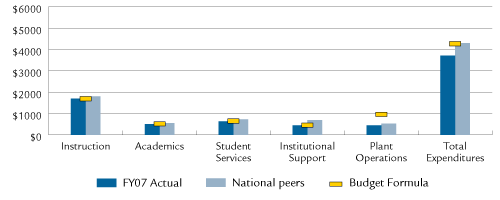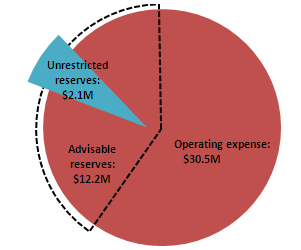Policy and Report Library > Reports > 2008 Performance Measurement Report
Cape Cod Community College
Cape Cod Community College (CCCC) delivers educational programs and services to meet the diverse needs of the residents of Cape Cod, the Islands and adjacent areas of Southeastern Massachusetts. As the sole comprehensive college on Cape Cod, it provides the only access to higher education for many residents. The College is a student-centered learning community that prepares students for a rapidly changing and socially diverse global economy.
Program of Distinction
Collaborations
Access Indicators
Affordability Indicators
Student Success and Academic Quality Indicators
Fiscal Effectiveness and Efficiency Indicators
Program of Distinction
Building on nearly two decades of environmental stewardship and national leadership, CCCC leads its region toward the coming “green” economy. New and incumbent workers can take academic courses and workforce training in renewable energy that integrate state-of-the-art information with hands-on experience. CCCC currently partners with the local Economic Development Council on a non-credit green jobs training program funded by the state’s Workforce Investment Fund, and this year was one of 20 colleges nationwide selected for a major Wal-Mart Foundation/ American Association of Community Colleges grant in support of certificates and degrees to prepare workers for a vital “green” economy. CCCC leads by example, aggressively reducing energy usage, paper consumption and greenhouse gas emissions, as well as implementing conservation, recycling and renewable energy production (photovoltaics, fuel cell and wind). For nearly 15 years, the College has realized substantial savings, dramatically reduced greenhouse gas emissions, and attracted much private philanthropy and many major grants (including Massachusetts Technology Collaborative and National Science Foundation). CCCC’s sustainability work is central to curriculum and teaching for the green jobs economy.
Collaborations
- College Connection, a collaboration between CCCC and area high schools, seeks to increase college-going rates by raising student awareness and expectations about college, and to reduce barriers for those who might never consider college. The program offers onsite enrollment services and academic resources at partner high schools, including information sessions for all students and their parents; assistance completing college applications and financial aid forms; assessment of college readiness; and, for those planning to attend CCCC, advisement and course registration. After a successful pilot at Falmouth High School (137% increase in college applications and 11% increase in CCCC enrollments among FHS graduates), four more high schools joined the program. Other districts will be added until all high schools in the region are served. To date, program costs have been covered by grants and private philanthropy.
- CCCC is the education partner in the Southeastern Massachusetts Healthcare Partnership (SMHP), a program funded by the Workforce Competitiveness Trust Fund through Commonwealth Corporation. The College develops curriculum, assesses basic skills and delivers courses for two innovative Healthcare Infomatics programs which train healthcare workers to examine and solve problems that require the integration of healthcare knowledge and information technologies. The College currently provides an entry-level academic certificate program designed to prepare health unit coordinators to take a national certification examination, and a certificate program that includes courses covering computer applications, project management, systems analysis, and healthcare informatics applied to health care theory and practice. These programs are available to Cape Cod Healthcare and Radius Healthcare employees. Graduates of the program will be qualified for a variety of positions in direct patient care, healthcare support and business departments in healthcare organizations.
- CCCC, a recognized leader and innovator in early childhood education and care, and one of the first colleges in Massachusetts accredited by the National Association for the Education of Young Children, works collaboratively with local employers providing opportunities for early childhood educators and childcare providers to earn and maintain state certification. College personnel provide leadership, planning, and course delivery for employees of Cape Cod Child Development, Cape Cod Childcare Network, Martha’s Vineyard Affordable Childcare and Young Children First. Last year, CCCC delivered six courses to 47 early childhood education and care professionals in three off-campus locations – Falmouth, Martha’s Vineyard, and Nantucket. Beginning Spring of 2009, CCCC will be one of five Massachusetts post-secondary institutions implementing Special Quest Curriculum – curriculum designed to improve teacher knowledge in caring for infants and toddlers with disabilities through the integration of content and field experiences.
- Through its Office of Advanced Studies, CCCC continues to broker broadly based collaborations among higher education institutions around the state, local K-12 school districts and local employers in business, healthcare and human services. CCCC currently offers nine master’s and six bachelor’s completion programs on campus, providing career and economic advancement for working adults for whom distance to the nearest four-year institutions would create difficult if not insurmountable barriers to advanced study. An external board (for Master’s degrees) and an internal committee manage an RFP process to select programs and provide quality oversight. Partner institutions reimburse CCCC for facility costs and provide funding for appropriate library and other resources to support the programs. The newest degree, added in Fall 2008, is a Master’s in Instructional Technology by Bridgewater State College, which developed as a result of needs identified by local superintendents of schools.
Section I: Access to Public Higher Education in Massachusetts
Access Indicators
Fall 2007 Enrollment
| Headcount |
4,434 |
| FTE |
2,450 |
Fall Enrollment
Over the last three years, fall headcount enrollment has increased 6.2%.
Over the last three years, fall full-time equivalent (FTE) enrollment has increased 7.8%.
Annual 2007–2008 Enrollment
| Headcount |
6,527 |
| FTE |
2,554 |
Annual Enrollment
Over the last three years, annual headcount enrollment has increased 2.8%.
Over the last three years, annual FTE enrollment has increased 3.9%.
Looking Back: Fall and Annual Headcount Enrollment

Fall 2007 Minority Enrollment
12.6%
Minority Enrollment
Greater than the minority representation of the institution's primary draw cities and towns (5.8%) and the Cape and Islands Region's minority representation of 6.2%.
Section II: Affordability of Massachusetts Community Colleges
Affordability Indicator
2007–2008 Tuition and Fees as a Percent of Median Family Income
5.0%
% of Median Family Income
Comparable to the Northeast regional average of 4.9%.
Looking Back: Tuition and Fees as a Percent of Median Family Income
|
FY2004 |
FY2005 |
FY2006 |
FY2007 |
FY2008 |
| Cape Cod Community College Tuition and Fees |
$3,180 |
$3,660 |
$3,660 |
$3,660 |
$3,946 |
| State Median Family Income |
$67,527 |
$68,701 |
$71,655 |
$74,463 |
$78,497 |
| "X" as a Percent of State Median Family Income |
| X = Cape Cod Community College Tuition and Fees |
4.7% |
5.3% |
5.1% |
4.9% |
5.0% |
| X = Massachusetts Community Colleges' Average Tuition and Fees |
4.8% |
4.9% |
4.9% |
4.7% |
4.7% |
| X = Northeast Average Tuition and Fees |
|
4.8% |
4.8% |
4.9% |
4.9% |
Section III: Student Success and Academic Quality
Success and Quality Indicators
Fall 2006 Cohort First-Year Persistence Rate
| Retained at original institution |
55.7% |
| Retained at any institution |
67.5% |
Fall Cohort First-Year Persistence
Persistence at original institution has remained relatively stable over the last three years and is comparable to the segmental average of 56.5%.
Looking Back: Fall-to-Fall First-Year Persistence Rate

Fall 2003 Cohort Four-Year Overall Success Rate
66.6%
Fall 2003 Cohort Four-Year Individual Success Rates
| Earned Degree/Certificate |
24.1% |
| Transferred |
14.6% |
| Earned 30 Credits |
26% |
| Still Enrolled |
1.8% |
| Note: Each subsequent category excludes any student included in previous category(ies) |
Fall Cohort Four-Year Overall Success Rate
This new indicator measures students who have earned a degree/certificate, transferred to another institution, earned 30 or more credits, or are still enrolled after four years. Future reports will include these outcomes over four, five, and six years for this and successive cohorts. Please see the Technical Guide for further details regarding this indicator.
2007–2008 Fall-to-Spring Retention Rate
88.5%
Fall-to-Spring Retention Rate
Fall-to-spring retention has remained relatively stable over the last three years.
FY2008 Credit Course Completion Rate
74.1%
Course Completion
Comparable to the Board of Higher Education's target rate of 75%.
Total Degrees Conferred in FY2008
534
Degrees Conferred
Average degrees conferred per year over the last three years: 484
Looking Back: Degrees Conferred

2007 Pass Rate on the National Nursing Licensure Examination
86%
Nursing Exam Pass Rate
Above the Board of Higher Education's target pass rate of 85%.
FY2008 Annual Enrollment in Workforce Development Courses
2,265
Workforce Development
Average annual enrollment in workforce development courses per year over the last three years: 2,257
Section IV: Effective and Efficient Use of Resources
Effectiveness and Efficiency Indicators
Effective Projects and Initiatives
- Improved campus physical security by installing a public address system, E911, a campus-wide network access lock system, and a digital entry sign funded mostly by a capital appropriation from the state.
- Implemented a disaster recovery plan which includes a portable storage-area network server that can be transported to Bridgewater State College in the event of an emergency on Cape Cod.
- Negotiated a ten-year contract for support of the Jenzabar student information system that saves the College $1.25 million over ten years.
Resource Allocation
Expenditures per Student—Actual, National Peers, and Budget Formula

Note: This graphic was revised on May 6, 2009. The previously posted graphic displayed the data inaccurately.
FY2008 Primary Reserve Ratio
| Unrestricted Reserves (UR) |
$2,155,115 |
| Total Operating Expenses (TOE) |
$30,540,255 |
| Primary Reserve Ratio (UR/TOE) |
7.1% |
Primary Reserve Ratio

Compliance
No materials weaknesses based on annual external independent audit:

